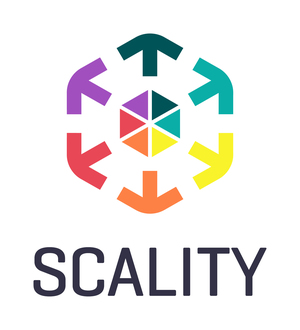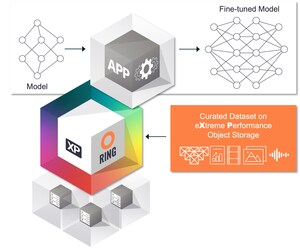SAN FRANCISCO, Dec. 1, 2020 /PRNewswire/ -- Scality, the leader in software solutions for distributed file and object storage, today announced its data storage predictions for 2021, focusing on the rapid growth rate of cloud-native apps and containerization. According to IDC, by 2023, over 500 million digital apps and services will be developed and deployed using cloud-native approaches. That is the same number of apps developed in total over the last 40 years.
"The accelerated growth of next-generation cloud-native digital apps and services will define new competitive requirements in every industry. Cloud native and containers are rapidly turning into the new blueprint for application development and underlying cloud infrastructure services," explains Giorgio Regni, CTO at Scality. "For the storage industry, the container trend represents a significant inflection point that will transform deployment architectures leveraging Kubernetes and container-native storage APIs. Its impact will be comparable to that of server virtualization in the 2000s and cloud computing in the 2010s."
Scality's Chief Product Officer Paul Speciale added, "2021 will see a number of trends emerge as enterprise IT teams and storage vendors adapt in order to support the rise of cloud-native apps and the subsequent change in application and cloud infrastructure models."
Scality's predictions for 2021:
New container-centric storage solutions will emerge
Storage vendors in 2021 will create solutions to address the increasing scale and agility demands of container-based services, including boot volumes and logs, transactional databases, application data over traditional file and new object APIs, as well as backup and long-term archives. New container-centric storage products will be developed to enable traditional data-centric applications, as well as object storage and backups, to access Container Storage Interface (CSI)-type persistent volumes and radically reduce the complexity of large-scale Kubernetes deployments.
Hybrid cloud data management will be adopted for disaster recovery
Disaster Recovery (DR) across two physical data centers will no longer be required in 2021. Instead, hybrid cloud DR solutions that manage synchronized copies of critical data on-premises and in the public cloud will enable IT leaders to avoid the costs required to maintain and service two remote locations for DR, thereby saving thousands, if not millions, of dollars.
Flash media will be embraced for high-capacity storage
A new generation of high-density flash storage will become widely available in 2021. The optimal combination of high performance and lower prices makes it suitable for scale-out high-capacity file and object storage. Until now, flash storage has been deployed in smaller capacity applications and latency-sensitive use cases, while high-density spinning disk has been the preferred storage medium for large volumes of data (for example, media files or medical images). With the introduction of lower-cost, higher-density flash media in 2021, these use cases will adopt capacity-optimized solutions that maximize these benefits in density, scale and agility for multiple workloads.
Object storage will become a de facto storage model for data lakes
Research and Markets estimates that by 2025 data lakes will grow into a $20.1 Billion market. To fully analyze and take advantage of the wealth of information and insight in these massive data repositories, organizations require a foundational storage layer that makes data accessible and useful. In 2021 object storage will fulfill this role, becoming the dominant storage interface for analytics applications, such as Cloudera, Elastic, Spark, Splunk, Vertica, Weka and many others. This is because analytics applications leverage the AWS S3 API, the standard API for object storage; large semi-structured and unstructured data sets are a natural fit for object storage; and performance and capacity resources can scale independently since object storage decouples the application compute tier from the storage tier.
2021 will see an increased convergence of object and file storage for unstructured data
Organizations today are prioritizing data storage that scales both in capacity and in the breadth of applications that it supports. Cloud-native applications, which naturally consume and interact with object storage over S3 API, are increasingly deployed in the enterprise alongside long-standing applications that access file system storage. As a result, solutions that combine file and object models into single unified systems will prevail in the enterprise starting in 2021.
The service mesh will be adopted to connect and secure workloads
Complex cloud-native applications that straddle cloud regions, on-premises core data centers and edge locations are becoming increasingly popular. Yet secure communication between these services remains a challenge, particularly as the rise in remote working strains legacy network and firewall designs. In 2021, 'service mesh' approaches to secure network communication will be broadly adopted. Such approaches will enforce Transport Layer Security (TLS) and authentication and access control for both workload connectivity as well as towards the edge. This gradually introduces 'zero-trust' networks (spearheaded by Google's BeyondCorp framework) where network policies can be codified and systematically deployed and enforced.
About Scality:
Scality® is a market-leading software-defined file and object platform designed for on-premise, hybrid and multi-cloud environments. We give customers the freedom and control necessary to compete in a data-driven economy. Follow us @scality and LinkedIn. Visit www.scality.com or subscribe to our company blog SOLVED.
Contacts:
Kristen Wiltse - US
A3 Communications
978-927-1747
[email protected]
Federica Monsone - EMEA
A3 Communications
+44 1252 875 203
[email protected]
SOURCE Scality

Related Links
WANT YOUR COMPANY'S NEWS FEATURED ON PRNEWSWIRE.COM?
Newsrooms &
Influencers
Digital Media
Outlets
Journalists
Opted In





Share this article